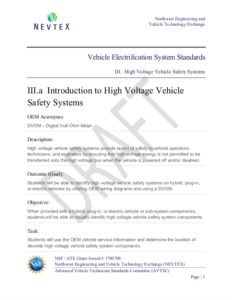Vehicle Electrification Systems Standards: High Voltage Vehicle Safety

Vehicle Electrification Systems Standards Curriculum Description:
The Vehicle Electrification Systems Standards curriculum is provided by the Northwest Engineering and Vehicle Exchange (NEVTEX) and was developed by Central Oregon Community College (COCC) and Rio Hondo College (RHC). COCC and RHC worked together "to develop curriculum and training standards for technicians in hybrid electric vehicle (HEV), electric vehicle (EV), and Fuel Cell (FC) vehicle systems." This curriculum was developed with the intention of addressing industry needs by partnering with industrial and educational representatives to obtain input and assistance to develop:
- new approaches to prepare an advanced technologies workforce,
- licensure procedures and policies to ensure the safety of technicians, their employers, and clients, and
- collaboration between educational and industrial partners in the development of new standards and practices.
The Vehicle Electrification Systems Standards are divided into 11 topics. This section of the standards covers the topic High Voltage Vehicle Safety. The other 10 topics and a Master Acronym and Definition list are available to view separately.
High Voltage Vehicle Safety Description and Contents:
This section of the Standards includes the following five lesson plan outlines: III. a Introduction to High Voltage Vehicle Safety Systems, III. b Manual/Service Disconnect Systems, III. c High Voltage Interlock Systems, III. d High Voltage Bus Discharge Systems, III. e High Voltage Isolation Fault Detection Systems. These lesson plan outlines include a description, outcome, objective, and student task.
The introduction lesson plan has students use "... the OEM vehicle service information and determine the location of discrete high voltage vehicle safety systems components."
The manual/service disconnect systems lesson plan has students "us[ing] high voltage personal protective equipment and the OEM service information procedure to remove the MSD to disable the high voltage system."
The interlock systems lesson plan has students "... locate and identify each component that utilizes an HVIL connection."
The bus discharge systems lesson plan has students "... disable the high voltage system, disassemble the component that serves as the high voltage distribution center, defeat the interlock circuit (if necessary), and measure bus voltage with a DVQM when the vehicle is powered ON and OFF to observe the operation of the bus discharge circuits."
The fault detection systems lesson plan has students verify the isolation fault detection circuits are operating correctly in a provided hybrid, plug-in, or electric vehicle.
About this Resource


Comments